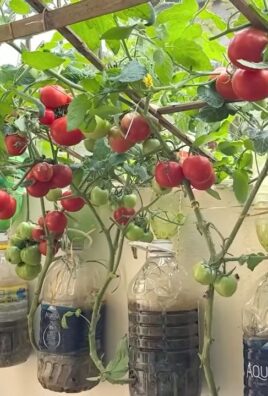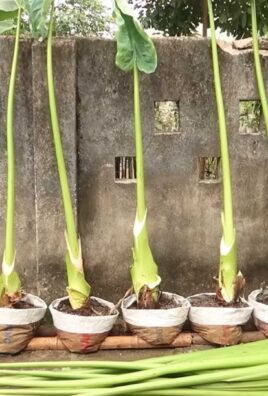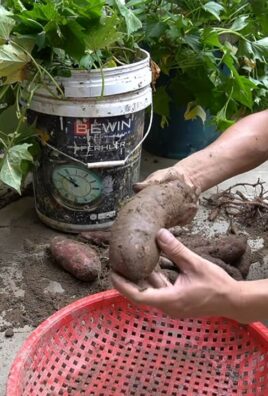Grow Lemongrass at Home and transform your kitchen into a fragrant oasis! Have you ever dreamt of snipping fresh lemongrass straight from your garden for your Thai curries or soothing teas? It’s easier than you think, and this DIY guide will show you exactly how to make that dream a reality.
Lemongrass, with its vibrant citrusy aroma, has been a staple in Asian cuisine and traditional medicine for centuries. Originating in Southeast Asia, it’s revered not only for its culinary uses but also for its potential health benefits, from aiding digestion to repelling insects. Imagine having this versatile herb readily available, adding a touch of exotic flavor to your meals and a refreshing scent to your home.
In today’s busy world, convenience is key. Instead of relying on store-bought lemongrass, which can sometimes be wilted or expensive, why not grow lemongrass at home? This DIY project is not only cost-effective but also incredibly rewarding. I’ll walk you through simple steps, from selecting the right lemongrass stalks to providing the ideal growing conditions. Whether you have a sprawling garden or just a sunny windowsill, you can successfully cultivate this amazing herb. Get ready to enjoy the fresh, zesty flavor of homegrown lemongrass – you’ll wonder why you didn’t start sooner!

Grow Your Own Lemongrass: A Beginner’s Guide
Hey there, fellow plant enthusiasts! Ever dreamt of having fresh, fragrant lemongrass right at your fingertips? Well, dream no more! Growing lemongrass at home is surprisingly easy, and I’m here to walk you through every step of the process. Trust me, the satisfaction of snipping off your own homegrown lemongrass for a delicious Thai curry or a soothing cup of tea is absolutely worth it.
Choosing Your Lemongrass Starting Point
Before we dive into the nitty-gritty, let’s talk about where you’ll get your lemongrass. You have a few options:
* Grocery Store Stalks: This is the most common and budget-friendly method. Look for lemongrass stalks at your local Asian grocery store or even some well-stocked supermarkets. Choose stalks that are firm, healthy-looking, and have a bulbous base. Avoid any that are dried out, mushy, or showing signs of mold.
* Lemongrass Plant from a Nursery: If you want a head start, you can purchase a small lemongrass plant from a nursery or garden center. This option is a bit more expensive, but it can save you some time and effort.
* Cuttings from a Friend: If you know someone who already grows lemongrass, ask if they’d be willing to share a cutting. This is a great way to get a free plant and connect with fellow gardeners!
Rooting Lemongrass Stalks in Water
This is the method I usually use, and it’s super simple! We’re essentially tricking the lemongrass into thinking it’s still growing in the ground.
1. Prepare the Stalks: Once you have your lemongrass stalks, trim off the top few inches of the leaves, leaving about 4-5 inches of the stalk intact. This helps the plant focus its energy on root development rather than leaf growth.
2. Find a Suitable Container: Grab a glass or jar that’s tall enough to hold the stalks upright. A mason jar or even a recycled glass bottle works perfectly.
3. Add Water: Fill the container with fresh, clean water. Make sure the water level covers the bottom 1-2 inches of the stalks.
4. Place the Stalks in Water: Arrange the lemongrass stalks in the container, ensuring that the bulbous base is submerged in water.
5. Find a Sunny Spot: Place the container in a warm, sunny location, such as a windowsill that receives plenty of sunlight. Lemongrass loves sunshine!
6. Change the Water Regularly: Change the water every 1-2 days to prevent bacteria growth and keep the water fresh. This is crucial for successful rooting.
7. Be Patient: It usually takes about 2-3 weeks for roots to start appearing. You’ll see small, white roots emerging from the base of the stalks. Don’t get discouraged if it takes a little longer; just keep changing the water and providing plenty of sunlight.
Planting Your Rooted Lemongrass
Once your lemongrass stalks have developed a good network of roots (at least an inch or two long), it’s time to plant them in soil!
1. Choose the Right Pot (or Garden Spot): Lemongrass can grow quite large, so choose a pot that’s at least 12 inches in diameter. If you’re planting it in the ground, make sure you have enough space for it to spread. Lemongrass prefers well-draining soil, so avoid heavy clay soils that retain too much water.
2. Prepare the Soil: Use a good-quality potting mix that’s rich in organic matter. You can also amend your garden soil with compost or well-rotted manure to improve drainage and fertility.
3. Planting in a Pot: Fill the pot with potting mix, leaving a few inches of space at the top. Gently remove the rooted lemongrass stalks from the water and plant them in the pot, burying the roots completely. Space the stalks a few inches apart if you’re planting multiple stalks in the same pot.
4. Planting in the Ground: Dig a hole that’s slightly larger than the root ball of the lemongrass. Gently remove the rooted lemongrass stalks from the water and plant them in the hole, ensuring that the top of the root ball is level with the surrounding soil. Space the plants about 2-3 feet apart if you’re planting multiple plants.
5. Water Thoroughly: After planting, water the lemongrass thoroughly to help settle the soil and encourage root growth.
Caring for Your Lemongrass
Now that your lemongrass is planted, it’s time to provide it with the care it needs to thrive.
1. Sunlight: Lemongrass needs at least 6 hours of sunlight per day. Place your potted lemongrass in a sunny location, or choose a sunny spot in your garden for planting.
2. Watering: Water your lemongrass regularly, especially during hot, dry weather. The soil should be kept consistently moist, but not waterlogged. Check the soil moisture by sticking your finger into the soil; if it feels dry to the touch, it’s time to water.
3. Fertilizing: Feed your lemongrass with a balanced fertilizer every 2-3 weeks during the growing season (spring and summer). You can use a liquid fertilizer or a slow-release granular fertilizer.
4. Pruning: Prune your lemongrass regularly to encourage new growth and prevent it from becoming too leggy. Trim off any dead or yellowing leaves. You can also harvest the stalks as needed for cooking or tea.
5. Overwintering (for colder climates): Lemongrass is a tropical plant and is not frost-hardy. If you live in a colder climate, you’ll need to bring your potted lemongrass indoors before the first frost. Place it in a sunny location and water it sparingly during the winter months. If you’ve planted your lemongrass in the ground, you can try to overwinter it by covering it with a thick layer of mulch. However, it’s often easier to dig it up and pot it before the first frost.
Harvesting Your Lemongrass
The best part of growing your own lemongrass is, of course, harvesting it!
1. When to Harvest: You can start harvesting lemongrass when the stalks are at least 1/2 inch thick.
2. How to Harvest: Use a sharp knife to cut the stalks at the base, near the soil level. You can harvest as many stalks as you need, but be sure to leave some stalks intact to allow the plant to continue growing.
3. Using Your Harvest: Fresh lemongrass can be used in a variety of dishes, including soups, curries, stir-fries, and teas. To use lemongrass, simply bruise the stalk to release its flavor and aroma. You can also chop or mince the stalk for use in recipes.
Troubleshooting
Even with the best care, you might encounter a few problems along the way. Here are some common issues and how to address them:
* Yellowing Leaves: This can be caused by a variety of factors, including overwatering, underwatering, nutrient deficiencies, or pests. Check the soil moisture and adjust your watering accordingly. Fertilize your lemongrass with a balanced fertilizer. Inspect the plant for pests, such as aphids or spider mites, and treat them accordingly.
* Slow Growth: This can be caused by insufficient sunlight, poor soil, or lack of fertilizer. Make sure your lemongrass is getting at least 6 hours of sunlight per day. Amend the soil with compost or well-rotted manure. Fertilize your lemongrass regularly during the growing season.
* Pests: Lemongrass is generally pest-resistant, but it can occasionally be attacked by aphids or spider mites. These pests can be controlled with insecticidal soap or neem oil.
Propagating Lemongrass
Once you have a thriving lemongrass plant, you can easily propagate it to create more plants!
1. Division: The easiest way to propagate lemongrass is by division. Simply dig up the plant and carefully separate the clumps of stalks. Each clump should have its own roots. Replant the clumps in separate pots or in the ground.
2. Cuttings: You can also propagate lemongrass from cuttings. Take a cutting from a mature stalk, making sure it has at least one node (the point where a leaf grows). Place the cutting in water and wait for roots to develop. Once the roots are an inch or two long, plant the cutting in soil.
Enjoy Your Homegrown Lemongrass!
And there you have it! You’re now equipped with the knowledge to grow your own lemongrass at home. With a little patience and care, you’ll be enjoying fresh, fragrant lemongrass in no time. Happy gardening!

Conclusion
So, there you have it! Growing lemongrass at home is not only achievable, but it’s also incredibly rewarding. Forget those wilted, overpriced stalks at the grocery store. Imagine stepping into your own backyard or onto your balcony and harvesting fresh, fragrant lemongrass whenever you need it. This DIY project is a game-changer for anyone who loves Southeast Asian cuisine or simply appreciates the invigorating aroma of this versatile herb.
Why is this a must-try? Because it puts you in control. You control the quality, the freshness, and the sustainability of your lemongrass supply. You’re reducing your carbon footprint by avoiding transportation and packaging. And, let’s be honest, there’s a certain satisfaction that comes from nurturing something from a simple stalk into a thriving plant. Plus, think of all the delicious dishes you can create! From Tom Yum soup to fragrant curries, your homemade lemongrass will elevate your cooking to a whole new level.
But the benefits don’t stop there. Lemongrass is also known for its medicinal properties. It’s a natural insect repellent, a digestive aid, and a source of antioxidants. Having a ready supply of fresh lemongrass means you can easily brew a soothing tea or add it to your bath for a relaxing and therapeutic experience.
Ready to take your lemongrass cultivation to the next level? Consider these variations:
* Container Gardening: If you’re short on space, lemongrass thrives in containers. Choose a large pot with good drainage and use a well-draining potting mix. This is perfect for balconies, patios, or even indoor growing with sufficient sunlight.
* Different Varieties: While the most common variety is *Cymbopogon citratus*, explore other lemongrass varieties like *Cymbopogon flexuosus* for slightly different flavor profiles and essential oil compositions.
* Companion Planting: Plant lemongrass alongside other herbs and vegetables that benefit from its insect-repelling properties. Basil, tomatoes, and peppers are all good companions.
* Hydroponics: For the more adventurous gardener, try growing lemongrass hydroponically. This method allows for faster growth and greater control over nutrient levels.
We’re confident that you’ll find growing lemongrass at home to be a simple and enjoyable experience. Don’t be intimidated! Even if you’re a beginner gardener, this project is very forgiving. The key is to provide plenty of sunlight, water, and well-draining soil.
So, what are you waiting for? Grab a few stalks of lemongrass from your local Asian market, follow our simple steps, and get ready to enjoy the fruits (or rather, the stalks) of your labor. We can’t wait to hear about your success! Share your experiences, tips, and photos with us in the comments below. Let’s create a community of home-grown lemongrass enthusiasts! Let us know how your **grow lemongrass at home** project is going.
Frequently Asked Questions (FAQ)
How long does it take for lemongrass to grow from a stalk?
The time it takes for lemongrass to grow from a stalk can vary depending on environmental conditions, but generally, you can expect to see new growth within 2-4 weeks. The key is to provide consistent moisture and warmth during the rooting process. Once the roots are established, the plant will start to grow more rapidly. Be patient, and don’t be discouraged if you don’t see immediate results.
What kind of soil is best for growing lemongrass?
Lemongrass thrives in well-draining soil that is rich in organic matter. A sandy loam is ideal, but you can also amend your existing soil with compost or other organic materials to improve drainage and fertility. Avoid heavy clay soils, as they can become waterlogged and lead to root rot. When planting in containers, use a high-quality potting mix that is specifically formulated for herbs or vegetables.
How much sunlight does lemongrass need?
Lemongrass needs at least 6-8 hours of direct sunlight per day to thrive. If you’re growing it indoors, place it near a sunny window or supplement with a grow light. Insufficient sunlight can result in leggy growth and reduced flavor. If you live in a particularly hot climate, you may need to provide some afternoon shade to prevent the leaves from scorching.
How often should I water my lemongrass plant?
Water your lemongrass plant regularly, especially during hot and dry weather. The soil should be kept consistently moist, but not waterlogged. Check the soil moisture by sticking your finger into the soil. If the top inch feels dry, it’s time to water. Reduce watering during the winter months when the plant is not actively growing.
How do I harvest lemongrass?
To harvest lemongrass, simply cut the stalks near the base of the plant. Use a sharp knife or pruning shears to make a clean cut. You can harvest individual stalks as needed, or you can harvest the entire plant at once. The outer stalks are typically the thickest and most flavorful. After harvesting, remove any dry or damaged leaves.
Can I grow lemongrass indoors?
Yes, you can grow lemongrass indoors, but it requires sufficient sunlight. Place the plant near a sunny window that receives at least 6 hours of direct sunlight per day. You may also need to supplement with a grow light, especially during the winter months. Ensure that the pot has good drainage and water regularly.
Is lemongrass a perennial or an annual?
Lemongrass is a perennial in warm climates (USDA zones 9-11). In colder climates, it is typically grown as an annual or overwintered indoors. If you live in a cold climate, you can bring your lemongrass plant indoors before the first frost and keep it in a sunny location until spring.
How do I overwinter lemongrass?
To overwinter lemongrass, dig up the plant before the first frost and pot it in a container. Cut back the foliage to about 6 inches. Place the plant in a cool, bright location, such as a sunny window or a greenhouse. Water sparingly, allowing the soil to dry out slightly between waterings. In the spring, gradually acclimate the plant to outdoor conditions before planting it back in the garden.
What are some common problems with growing lemongrass?
Some common problems with growing lemongrass include root rot, spider mites, and aphids. Root rot can be prevented by ensuring that the soil is well-draining and avoiding overwatering. Spider mites and aphids can be controlled with insecticidal soap or neem oil. Regularly inspect your plants for signs of pests or diseases.
Can I propagate lemongrass from seed?
While it is possible to propagate lemongrass from seed, it is generally easier and more reliable to propagate it from stalks. Seeds can be difficult to germinate and may not produce plants that are true to type. If you do choose to grow from seed, start them indoors in early spring and transplant them outdoors after the last frost.




Leave a Comment